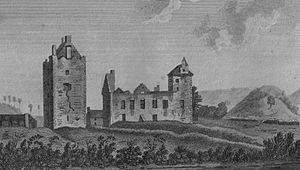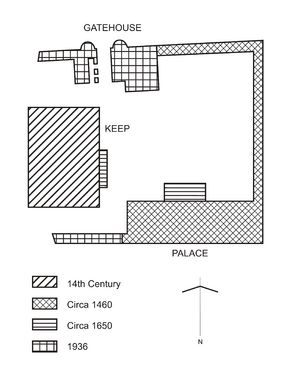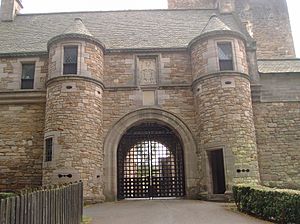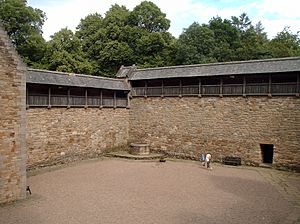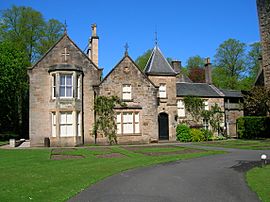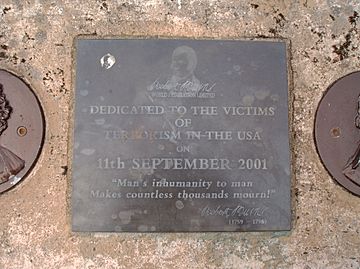Dean Castle facts for kids
Quick facts for kids Dean Castle |
|
|---|---|
| Kilmarnock, East Ayrshire, Scotland GB |
|

Dean Castle seen the front lawn
|
|
| Coordinates | 55°37′24″N 4°29′02″W / 55.6233°N 4.4839°W |
| Type | Tower house with courtyard |
| Height | 3.5 |
| Site information | |
| Owner | East Ayrshire Council |
| Open to the public |
Yes, free of charge |
| Condition | Preserved |
| Site history | |
| Built | c. 1350 |
| Built by | Thomas Boyd |
| In use | Until c. 1975 |
| Materials | Stone |
Dean Castle is a historic castle located in the Dean Castle Country Park in Kilmarnock, East Ayrshire, Scotland. For over 400 years, it was the main home for the Clan Boyd family, who were important lords in the Kilmarnock area.
The castle gets its name from 'The Dean', which means a wooded valley. This is a common name for places in Scotland. However, before about 1700, it was known as Kilmarnock Castle. The Boyd family originally owned it. The castle has strong links to many famous people and events in Scottish history. These include Robert the Bruce, who gave the Boyds their land, and James III of Scotland, whose sister married a Boyd. The castle also held Covenanters as prisoners. Bonnie Prince Charlie's rebellion in 1745 was joined by the 4th Earl of Kilmarnock from this castle. Even Robert Burns, a famous Scottish poet, was encouraged to publish his poems by the Earl of Glencairn, who owned the castle at that time.
Contents
History of Dean Castle
The Boyd family first got the land where Dean Castle stands in 1316. This happened when Sir Robert Boyd was given the lands of Kilmarnock and West Kilbride. He received this reward from King Robert I for his help in the Battle of Bannockburn.
Building the Keep
The oldest part of the castle is called the Keep. It was built around 1350 by Sir Thomas Boyd, the son of Sir Robert Boyd. The Keep was mainly built for defence. Its walls are very thick, about 2 to 3 metres (6 to 10 feet). It has only a few windows. The first entrance was high up from the ground.
Interestingly, Dean Castle's Keep does not have arrowslits. These are narrow openings in walls for archers to shoot through. This is very unusual for a Scottish castle from this time. All the shooting from Dean Castle was done from the battlements at the very top.
The Palace Section
The first part of the Palace was built in the mid-1300s by Sir Robert Boyd (the 1st Lord Boyd) and his son, Sir Thomas Boyd. The land was given to Sir Robert Boyd because he was very loyal during the Scottish Wars for Independence.
In 1735, a fire accidentally started in the Palace kitchen. The fire then spread to the thatched roof and onto the roof of the Keep. After this, the castle was left in ruins and was neglected for almost 200 years. However, some parts of the buildings were still used. The person living in the castle at the time, William Boyd, the 4th Earl of Kilmarnock, had money problems. He could not afford to fix the castle.
Restoring Dean Castle
James Boyd sold the castle in 1746, and it changed owners many times. Later, the 8th Lord Howard de Walden inherited the castle. He decided to start restoring it. He finished fixing the Keep in 1908 and completed the Palace restoration in 1946.
The Gatehouse you see today was built much later, in 1935–36. It was not part of the original castle. However, its design carefully copies real buildings from the 1500s. This includes details like the windows with half-wooden shutters and half-leaded glass. The overall look and the decorative gun loops are copied from the gatehouse at Tolquhon Castle in Aberdeenshire, built in the 1580s. The wooden walkway around the wall, which protected the Palace, was also added during the restoration. In 1971, the castle and gatehouse were recognized as a Category A listed building, meaning they are very important historically.
Inside Dean Castle
The Keep's Floors
The Keep has four floors, each with a special purpose.
Ground Floor
The ground floor held the cellar. This is where the original kitchen for the Great Hall above was located. Also on the ground floor was a narrow dungeon. When the Keep was first built, you could only get to the kitchen and dungeon from the first floor using a ladder. There were no doors leading outside.
First Floor
The first floor is home to the Great Hall. It has a large vaulted ceiling. The Great Hall was mainly used for big parties and entertainment for the lord and his guests. Guests staying at the castle would often sleep on the floor of the Great Hall. This hall also served as a court, where the lord would act as a judge. He would decide on crimes committed in the area.
The first floor also has a minstrel's gallery. This is where travelling minstrels would play music and perform for the Lord and Lady below. Off the minstrel's gallery is a changing room for the minstrels. Here, they would change into their bright costumes. This room was also used for them to sleep. They had their own private space because people worried they might carry diseases. This kept them from passing any sickness to other guests.
The guard room is also on the first floor. This room has the only way to get into the dungeon: a small hole in the floor where prisoners were dropped in. A guard was always in this room to watch the dungeon and the only entrance to the castle, which was a small door above ground level next to the guard room.
Second Floor
The second floor holds the Solar. This was a large, private room for the Lord and Lady. The Solar could be divided into two parts using a large curtain, one side for ladies and the other for men. There are two fireplaces in the Solar, one on each side. The Solar also has a small private chapel. The Lord and Lady of the castle used this, and a priest living in the castle would lead services for the family. A small ladies' bowyer (a private sitting room) is also on this floor.
Third Floor
This floor is at the very top of the Keep. From here, archers could defend the castle if it was attacked. On the third floor, there are also small apartments where soldiers could stay.
The Palace's Design
The Palace was mainly designed for comfort, not just defence. On its ground floor was the kitchen, with a large fireplace and oven. The first floor had the banqueting hall. Above that, on the second floor, were bedrooms for the family. The first staircase leading to the first floor was made of wood and was outside the building. However, because of the wet Scottish weather, a stone staircase was later added inside the Palace.
Even though it was for comfort, defence was still important in the Palace's design. The tower has battlements that stick out. Lord Boyd's private rooms were inside this tower. This tower was known as the Laigh or Low Tower. Although it is tall, it is lower than the Keep. Also, the courtyard was protected by a high wall called the Barmkin. This wall protected other buildings in the courtyard, such as stables, storage areas, and blacksmiths.
Dean Castle Today
In 1975, the 9th Lord Howard de Walden gave the castle, its land, his father's collection of weapons and armour, and his grandfather's musical instruments to the people of Kilmarnock.
Today, the collections of weapons and armour are on display in the Great Hall of the Keep. The musical instruments are shown in the Solar of the Keep. The banqueting hall displays many items owned by East Ayrshire Council, including a special edition of Robert Burns' poetry and many artworks.
The private room of the Earls of Kilmarnock has a detailed model of the castle.
There's a story about the 4th Earl's head being kept in the castle. This story has made many ghost hunters interested in the castle. They believe there is a ghostly presence in the Palace.
A large statue of William Wallace, a Scottish hero, is on display on the ground floor of the Palace.
Dean Castle and Country Park are looked after by East Ayrshire Council. It is free to visit. There are also free daily tours of the castle.
The Robert Burns World Federation recently put up a plaque. It remembers those who lost their lives in the terrorist attacks on September 11, 2001. The plaque reads:
Dedicated to the victims of terrorism in the USA on 11 September 2001 "Man's Inhumanity to man Makes countless thousands mourn!"
Robert Burns (1759–1796)



